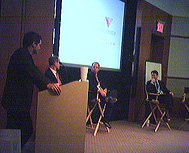 For Sarah McLachlan’s World On Fire video, they spent almost the whole production budget solving the problems she’s writing about rather than producing the video.
For Sarah McLachlan’s World On Fire video, they spent almost the whole production budget solving the problems she’s writing about rather than producing the video.
When Boots pharmacy customers weren’t taking advantage of a service that transfers prescriptions directly from the doctor, Marketing firm Naked Communications stepped in: “Boots discontinued its TV spots and had employees suggest the service to customers waiting in line for prescriptions. According to Chris Laud, Boots’ media manager, the number of participants in the program has skyrocketed several hundred percent at a fraction of the cost of the TV campaign.”
In Douglass Rushkoff’s new book he writes, “When things are down, CEO’s look to consultants and marketers to rethink, re-brand or repackage whatever it is they are selling, when they should be getting back on the factory floor, into the stores, or out to the research labs where their product is actually made, sold, or conceived.â€
If this is a larger trend, I think it’s because marketing has made consumers either cynical or confused, or both. There’s still a role for marketing to play in a customer-centric marketplace, but it requires collaborating with engineering and design rather than putting lipstick on pigs.
 I live in one of the art centers of the world — the West Chelsea section of Manhattan — and my opinion of today’s art can be summed up in one word: boring. Rarely do contemporary artists teach us anything, or even make us feel anything. The best art only manages commentary, as with
I live in one of the art centers of the world — the West Chelsea section of Manhattan — and my opinion of today’s art can be summed up in one word: boring. Rarely do contemporary artists teach us anything, or even make us feel anything. The best art only manages commentary, as with 
 My business partner
My business partner  Did Johnson & Johnson heed my
Did Johnson & Johnson heed my 

